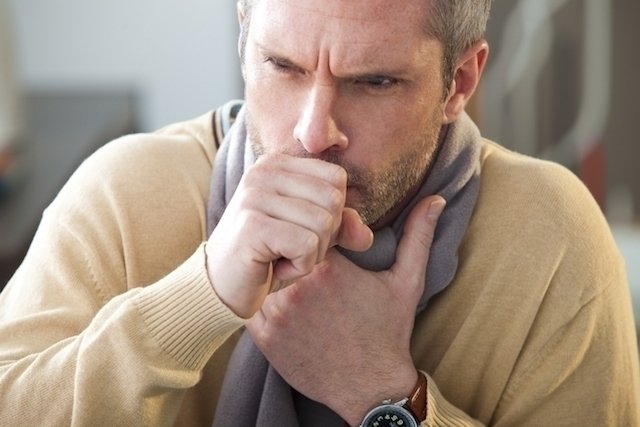Yellow phlegm is typically a sign of a bacterial respiratory infection, like bronchitis, strep throat or pneumonia.
It is normal to cough up yellow phlegm during bacteria infections, because when bacteria starts to grow in the throat or lungs, the clear mucus that is normally found along the respiratory tract becomes thicker and contains more white blood cells. This is one of the body's defense mechanisms to help collect any microorganisms along the tract so that they can be coughed up.
If you notice yellow phlegm and it is accompanied by other symptoms like fever, sore throat, or shortness of breath, you should see your doctor for assessment and possible. Also check out what different phlegm colors mean and how to treat it.

What causes yellow phlegm?
Yellow phlegm can occur for the following reasons:
1. Strep throat
Bacterial pharyngitis, or strep throat, is characterized by swelling of the pharynx due to a bacterial infection. In addition to yellow phlegm, some people may also experience intense sore throat, difficulty swallowing, fever and headache.
Read more about the symptoms, causes and treatment of strep throat.
What to do: If you suspect pharyngitis, you should see your doctor for evaluation. Treatment should be initiated, and may involve the use of antibiotics and analgesics to reduce inflammation, relieve pain and reduce any fever. Learn more about sore throat medications that the doctor may prescribe.
Also recommended: Tea for Sore Throat: 11 Natural Recipes to Relieve Pain tuasaude.com/en/tea-for-sore-throat2. Sinusitis
The presence of yellow phlegm may be a sign of bacterial sinusitis. This condition is characterized by swelling of the nasal cavities due to a bacterial infection.
With this condition, it is also common to notice a runny nose, fever, headache and difficulty breathing due to a plugged nose.
Also recommended: Chronic Sinusitis: Symptoms, Diagnosis, Causes & Treatment tuasaude.com/en/chronic-sinusitisWhat to do: Treatment for bacterial sinusitis should be monitored by a doctor. After evaluating your symptoms and confirming diagnosis, the doctor may prescribe antibiotics and other sinusitis medication. Inhaling warm vapor, or nebulizers, may also help to unplug your nose and facilitate breathing.
Check out other natural remedies for sinusitis you can try at home to relieve your symptoms quickly.
3. Bronchitis
Yellow phlegm may emerge in cases of bacterial bronchitis. This condition is characterized by swollen bronchi that produce a thicker mucus, which helps to eliminate any bacteria through coughing.
Other common symptoms of bronchitis include coughing, shortness of breath, fever and fatigue.
What to do: If your yellow phlegm may be occurring due to bronchitis, you should see your doctor for assessment and to start treatment. Treatment usually involves the use bronchitis medications like bronchodilators, anti-inflammatories, corticosteroids, and expectorants. Drinking lots of fluid can also help to eliminate mucus.
Learn more about home remedies for bronchitis that can help to relieve symptoms and speed-up recovery.
4. Pneumonia
Bacterial pneumonia is usually not contagious, but it can cause the production of yellow phlegm due to built-up bacteria in the lungs. It This condition may also result in green phlegm.
In addition to yellow phlegm, pneumonia can cause other symptoms like fever, chest pain, difficulty breathing and coughing. Learn about the symptoms of pneumonia and what can cause it.
What to do: Treatment for pneumonia usually involves the use of antibiotics, which are prescribed by a doctor following a thorough chest assessment. Read more about home remedies for pneumonia that can relieve symptoms like fever and coughing.
5. Pulmonary bronchiectasis
Yellow phlegm may also be associated with pulmonary bronchiestasis. This condition is characterized by increased dilation of the bronchi, due to an obstruction in the respiratory airways or due to a bacterial infection. It increases the production of thicker respiratory secretions.
One of the most common symptoms of bronchiestasis is phlegm, however you may also experience coughing with blood, shortness of breath, general malaise or chest pain.
What to do: Although there is no cure for this condition, treatment can be recommended to reduce symptoms. It may involve the use of antibiotics and bronchodilators to facilitate breathing.
Learn about the different home remedies you can use to get rid of your phlegm faster.
Also recommended: Green Phlegm: 9 Common Causes & What to Do tuasaude.com/en/green-phlegm6. Cystic fibrosis
Cystic fibrosis is a genetic disease that affects a protein in the body, known as CFTR. It is characterized by very thick and viscous secretions that are difficult to eliminate, accumulating mainly in the lungs and digestive tract.
In addition to yellow phlegm, other symptoms can also emerge, such as difficulty breathing,persistent shortness of breath, bulky and greasy stools, and constipation.
What to do: Treatment for cystic fibrosis usually involves the use of prescription medications, like bronchodilators, antibiotics, mucolytics and pancreatic enzymes.
Some patients may also benefit from respiratory physiotherapy sessions and nutritional monitoring with the aim of controlling the disease and improving quality of life.
